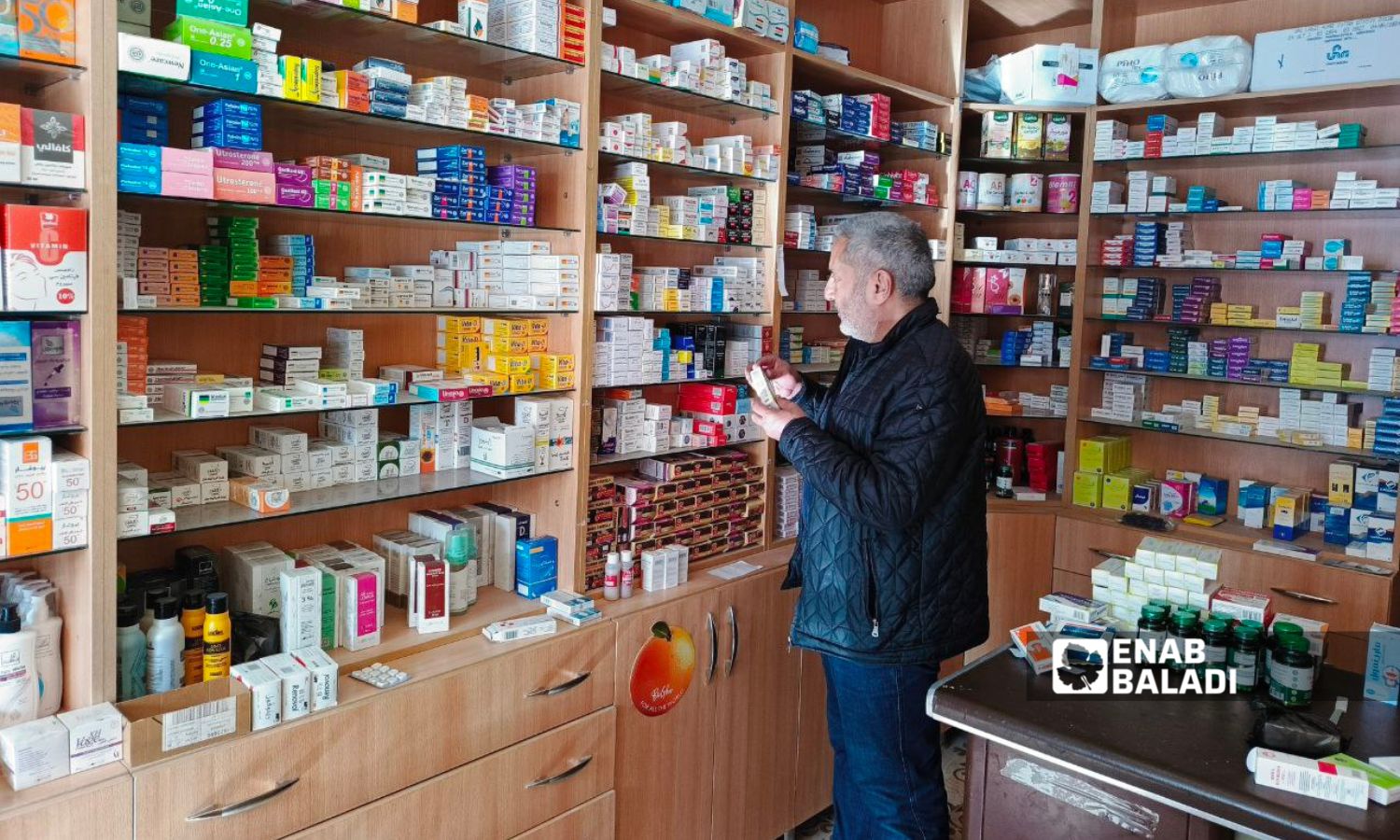



Daraa – Halim Muhammad
Drug prices remain high in Daraa province, southern Syria, despite the improvement in the value of the Syrian pound, with the dollar exchange rate reaching around ten thousand Syrian pounds.
According to Enab Baladi‘s monitoring, locally produced medicines are still being sold based on the previous pricing set by the Ministry of Health in Bashar al-Assad’s deposed government.
Additionally, some types of medications have disappeared from pharmacies due to the closure of some factories, prompting some patients to seek alternatives, such as purchasing imported drugs.
The prices of medications related to chronic diseases such as heart disease, diabetes, and hypertension are considered exorbitant compared to the economic and living conditions of the residents.
Ali Harfoush, 55, a resident of Daraa city, reported that the price of the medication for his neurological condition has not changed in months, noting that he needs around 150,000 Syrian pounds each month.
Sixty-something-year-old Saleh al-Masri expressed his disappointment over the unchanged drug prices, stating that his monthly medication costs reach 200,000 Syrian pounds, much of which goes towards his wife, who suffers from a neurological disease.
He told Enab Baladi that he now struggles to afford the medication, having borrowed money from several pharmacies to secure it, and he fears he won’t be able to continue doing so.
Al-Masri suffers from disc issues and needs to take painkillers regularly, mentioning that he spends two-thirds of his pension on medications.
Pharmacies in Daraa continue to adhere to the previous pricing set by the previous regime’s government in selling medications to residents, with no new price list issued following the fall of the Assad regime and the interim government taking charge.
Pharmacist Adel Nuwiran in Daraa city told Enab Baladi that the decision to adjust drug prices is linked to an official announcement issued by the Ministry of Health.
He added that factories submit cost assessments to the Pharmacists’ Syndicate and the specialized committees in the Ministry of Health, and based on that, prices are determined.
Pharmacist Amal Hariri stated that the Ministry and the Pharmacists’ Syndicate are responsible for adjusting the price list, and individual pharmacists cannot change it on their own due to the risk of penalties and fines.
Hariri called for an increase in the pharmacists’ profit margin, which currently does not exceed 20%, deeming it insufficient.
On the other hand, Najla al-Asimi, an employee in the drug monitoring section of Daraa Health Directorate, attributed the stability and lack of price decrease to the stoppage of some drug factories, with others still operating based on the old prices at which raw materials were purchased due to the high dollar rate.
Al-Asimi added that the directorate conducts inspection tours and price comparisons in most pharmacies in Daraa province.
Meanwhile, laboratory technician Alaa Ramilaoui, an employee in the drug monitoring section, noted that factories before the regime’s fall were sourcing raw materials at subsidized prices based on an exchange rate of 8,000 Syrian pounds per dollar.
After the regime’s fall, factories have continued to produce medications despite the liberalization of prices and the removal of subsidies; however, they no longer pay the financial toll to the former regime’s “shabiha,” creating a profit margin for these factories, according to Ramilaoui.
Daraa province has three drug factories, all of which are currently operational.
In addition to fixed prices, some patients complained about the reduced effectiveness of certain medications and a lack of availability, which has driven them to purchase the same type but from foreign sources at higher prices compared to locally produced drugs.
The prices of imported medical materials linked to the foreign exchange rate have decreased, as have the prices of domestically produced medical accessories and dietary supplements.
Pharmacist Amal Hariri mentioned that there are some types of medications, especially for chronic diseases, that are missing in most pharmacies due to the shutdown of some factories, adding that the alternative is often sourced from abroad.
Acting Minister of Health in Syria, Maher al-Sharaa, stated in a press conference attended by Enab Baladi that the ministry has inherited a heavy and dilapidated legacy in the health sector, vowing to gradually improve the sector and its personnel.
He noted that there are over 100 drug factories in Syria and that there had been a lack of regulation in the pharmaceutical manufacturing process and drug movement, leading to haphazard production where low-cost materials with quick turnover and high profit margins were prioritized.
He added that the ministry and its departments, including the drug monitoring directorate, have laid out a plan to impose regulations on factories to organize operations, claiming that a shortage and loss of medications would be remedied within a short period.
Most residents in Daraa directly consult pharmacies to diagnose certain ailments and obtain medications to avoid the added cost of a doctor’s consultation.
In January, Doctors Without Borders reported that over 70% of Syria’s population requires “urgent” humanitarian aid, noting that humanitarian efforts in the country face “significant challenges amidst increasing needs among the population.”
if you think the article contain wrong information or you have additional details Send Correction